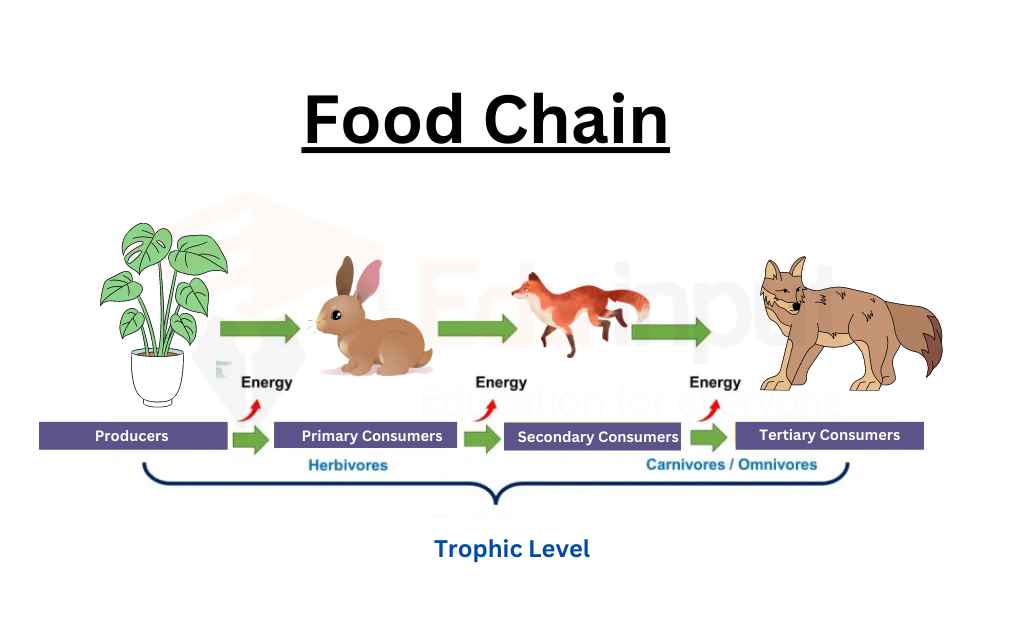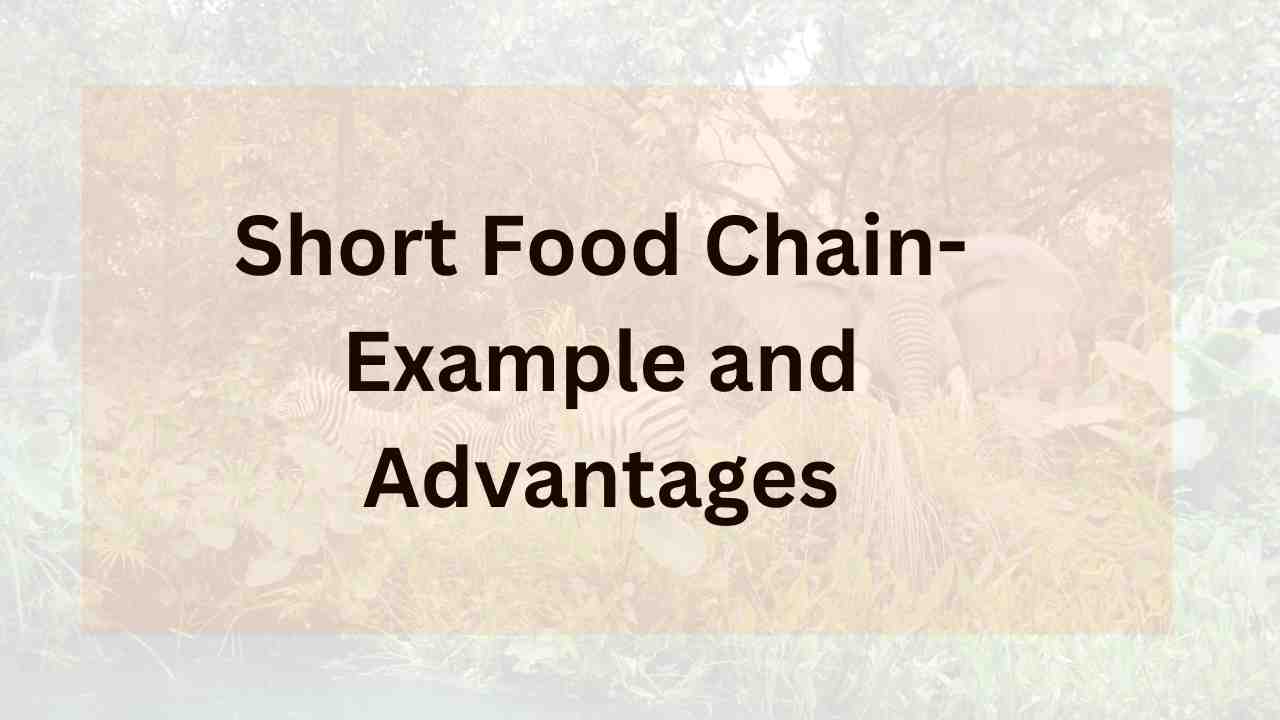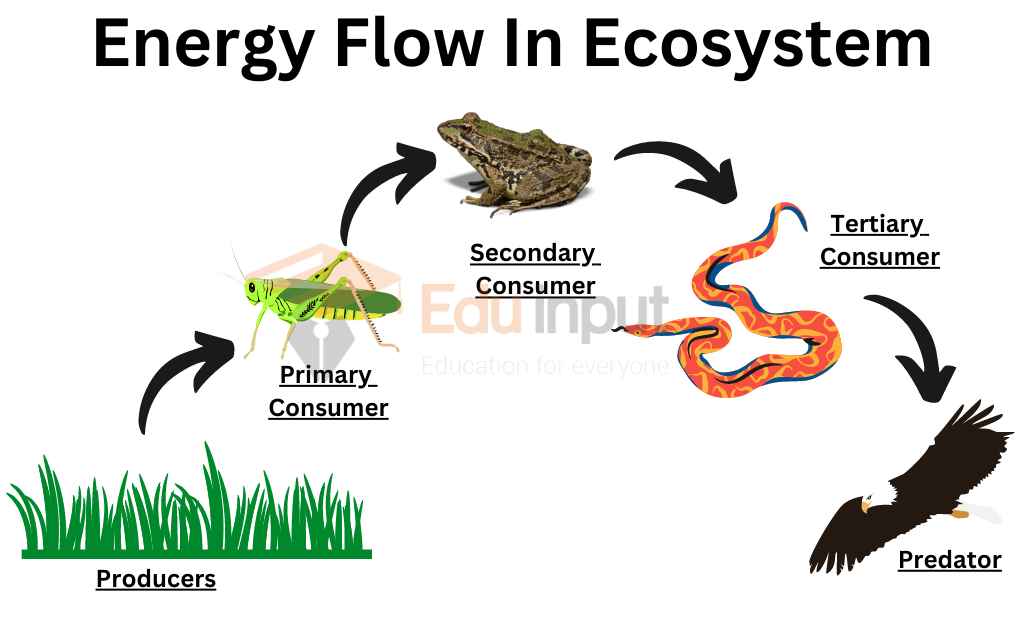Food Chain (Definition, Types, and Examples)
A food chain is a series of organisms in which each one is eaten by the next, forming an ecosystem’s energy transfer sequence.
The food chain is an essential component of the ecosystem because it regulates the balance of nature.
| Key Points |
|---|
| 1. A food chain is a series of organisms in which each one is eaten by the next, forming an ecosystem’s energy transfer sequence. 2. It regulates the balance of nature and is an essential component of the ecosystem. 3. The food chain pyramid is a graphical representation of the feeding relationships between different organisms in an ecosystem, with primary producers forming the foundation. 4. There are two types of food chains: the grazing food chain and the detritus food chain. 5. A food web is a network of interconnected food chains in an ecosystem, showing how different organisms are interconnected and depend on each other for survival. 6. Each organism in a food chain occupies a specific trophic level, including producers, herbivores, carnivores, and decomposers. 7. The ocean, desert, rainforest, and tundra have unique food chains. |
What is Food Chain?
A food chain is a series of organisms in an ecosystem in which each organism consumes the one below it and is consumed by the one above it.

This sequence of feeding relationships shows how energy is transferred from one organism to another in an ecosystem.
What is Food Pyramid?
The food chain pyramid is a graphical representation of the feeding relationships between different organisms in an ecosystem.
It shows the transfer of energy from one organism to another through a series of feeding interactions.
The pyramid is divided into several levels, known as trophic levels. At the base of the pyramid are the primary producers, such as plants, that make their food through photosynthesis. They form the foundation of the food chain and provide energy to all other organisms in the ecosystem.
The next level of the pyramid consists of herbivores, which are animals that eat plants. They obtain energy by consuming the primary producers. At the next level are carnivores, which are animals that eat other animals. They obtain energy by consuming herbivores or other carnivores.
The top level of the pyramid is occupied by the apex predator, which is the organism that has no natural enemies and is at the top of the food chain. In most ecosystems, the apex predator is a large carnivore that feeds on other carnivores or herbivores.
Types of Food Chain
There are wo types of food chain:
Grazing food chain
This type of food chain begins with green plants as the primary producers that make their own food through photosynthesis. Herbivores such as rabbits, deer, and cows consume the plants as their source of energy and nutrients.
In return, these herbivores become the food source for carnivores such as wolves, lions, and hawks. The grazing food chain typically has four to five trophic levels, with each level transferring only about 10% of the energy from the previous level. The rest of the energy is lost as heat or used for metabolism.

Detritus food chain
The detritus food chain, also known as the decomposer food chain, starts with dead organic matter such as fallen leaves, animal carcasses, and fecal matter. Detritivores, such as worms and insects, feed on this dead matter and break it down into smaller pieces.
This matter is then consumed by decomposers, such as bacteria and fungi, that break down the matter further into its basic nutrients, which are then released into the soil or water. These nutrients can then be taken up by plants, restarting the grazing food chain. It helps in nutrient cycling and decomposition in ecosystems.
Examples of food chain
Here are few examples of food chain:
Grass → Grasshopper → Frog → Snake → Hawk
In this food chain, the grass is the primary producer and the hawk is the top predator.
Phytoplankton → Zooplankton → Small Fish → Big Fish → Shark
In this food chain, the phytoplankton are the primary producers in the ocean, and the shark is the top predator.
Acorns → Mice → Snakes → Hawks
In this food chain, the acorns are the primary producer, and the hawk is the top predator.
Grass → Rabbit → Fox → Coyote
In this food chain, the grass is the primary producer, and the coyote is the top predator.
Algae → Krill → Penguin → Leopard Seal
In this food chain, the algae are the primary producers, and the leopard seal is the top predator.
Learn more about: Long Food Chain & Short Food Chain
What is food web?
A food web is a network of interconnected food chains in an ecosystem. It shows how different organisms are interconnected and how they depend on each other for survival.
Trophic Level in a Food Chain
Each organism in a food chain occupies a specific trophic level, which refers to its position in the food chain. The trophic levels include producers, herbivores, carnivores, and decomposers.
Producers are the organisms that make their own food through photosynthesis or chemosynthesis, and they occupy the first trophic level. Examples include plants, algae, and some bacteria.
Herbivores are animals that feed directly on producers and occupy the second trophic level. Examples include rabbits, deer, and grasshoppers.
Carnivores are animals that feed on other animals and occupy the third, fourth, or higher trophic levels. The higher the trophic level, the fewer the number of individuals in that level. Examples of carnivores include lions, wolves, and hawks.
Decomposers are organisms that break down dead plant and animal matter, and they occupy the final trophic level. Examples include bacteria, fungi, and worms.
Ocean Food Chain
The ocean food chain is a complex network of feeding relationships that occur in marine ecosystems. Phytoplankton are at the base of the ocean food chain, followed by small fish, larger fish, and then apex predators like sharks.
Desert Food Chain
The desert food chain consists of a few organisms due to the harsh environment. The food chain starts with plants like cactus, followed by small rodents and snakes, and ends with predators like hawks and eagles.
Rainforest Food Chain
The rainforest food chain is incredibly diverse due to the abundance of plants and animals. The food chain starts with producers like trees, followed by primary consumers like insects, and then secondary consumers like monkeys and jaguars.
Tundra Food Chain
The tundra food chain is relatively simple, with lichens and mosses being the primary producers, followed by herbivores like caribou and musk oxen, and then predators like wolves and bears.
Arctic Food Chain
The Arctic food chain is similar to the tundra food chain, but with additional organisms like Arctic cod, which are at the base of the food chain.
Marine Food Chain
The marine food chain is vast and complex due to the diversity of ocean life. The food chain starts with tiny phytoplankton and ends with apex predators like sharks and killer whales.
Savanna Food Chain
The savanna food chain is dominated by large herbivores like zebras, giraffes, and elephants, and the predators that feed on them, like lions.
FAQs
What animal is at the top of the food chain?
The animal at the top of the food chain varies depending on the ecosystem. In general, however, it is often a large predator that has few or no natural predators of its own.
Why are mushrooms important to the food chain?
Mushrooms are important as decomposers in the detritus food chain. They break down dead organic matter and release nutrients back into the ecosystem, which can be taken up by primary producers and used in the grazing food chain. Without decomposers like mushrooms, dead matter would accumulate and nutrients would be locked up, making them unavailable for other organisms.
Explain how energy flows in a food chain?
Energy flows through a food chain from the sun to the primary producers, such as plants, through the process of photosynthesis. As energy is transferred from one organism to the next, some of it is lost as heat or used for metabolism. This means that the amount of available energy decreases as it moves up the food chain.
What are the possible consequences of adding an organism to a food chain?
Adding an organism to a food chain can have both positive and negative consequences. If the organism is a predator, it may help control populations of other organisms and prevent overgrazing or overconsumption. However, if the organism is an invasive species, it may disrupt the balance of the ecosystem by outcompeting native species for resources.
Explain why decomposers are an important part of a food chain?
Decomposers are important in the food chain because they break down dead organic matter and release nutrients back into the ecosystem. Without decomposers, dead matter would accumulate and nutrients would be locked up, making them unavailable for other organisms.
Which taxon is at the base of the food chain?
The taxon at the base of the food chain is the primary producers, which are typically plants that make their own food through photosynthesis.
What are 5 food chain examples?
Here are five food chain examples:
Grass → Grasshopper → Mouse → Snake → Hawk
Algae → Krill → Penguin → Seal → Killer Whale
Acorns → Squirrel → Bobcat → Coyote → Mountain Lion
Phytoplankton → Zooplankton → Herring → Seal → Orca
Grass → Deer → Wolf → Scavengers (such as vultures)

 written by
written by 





Leave a Reply